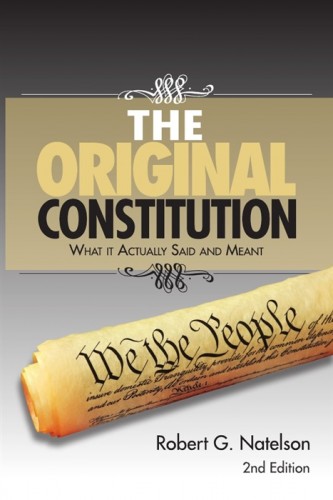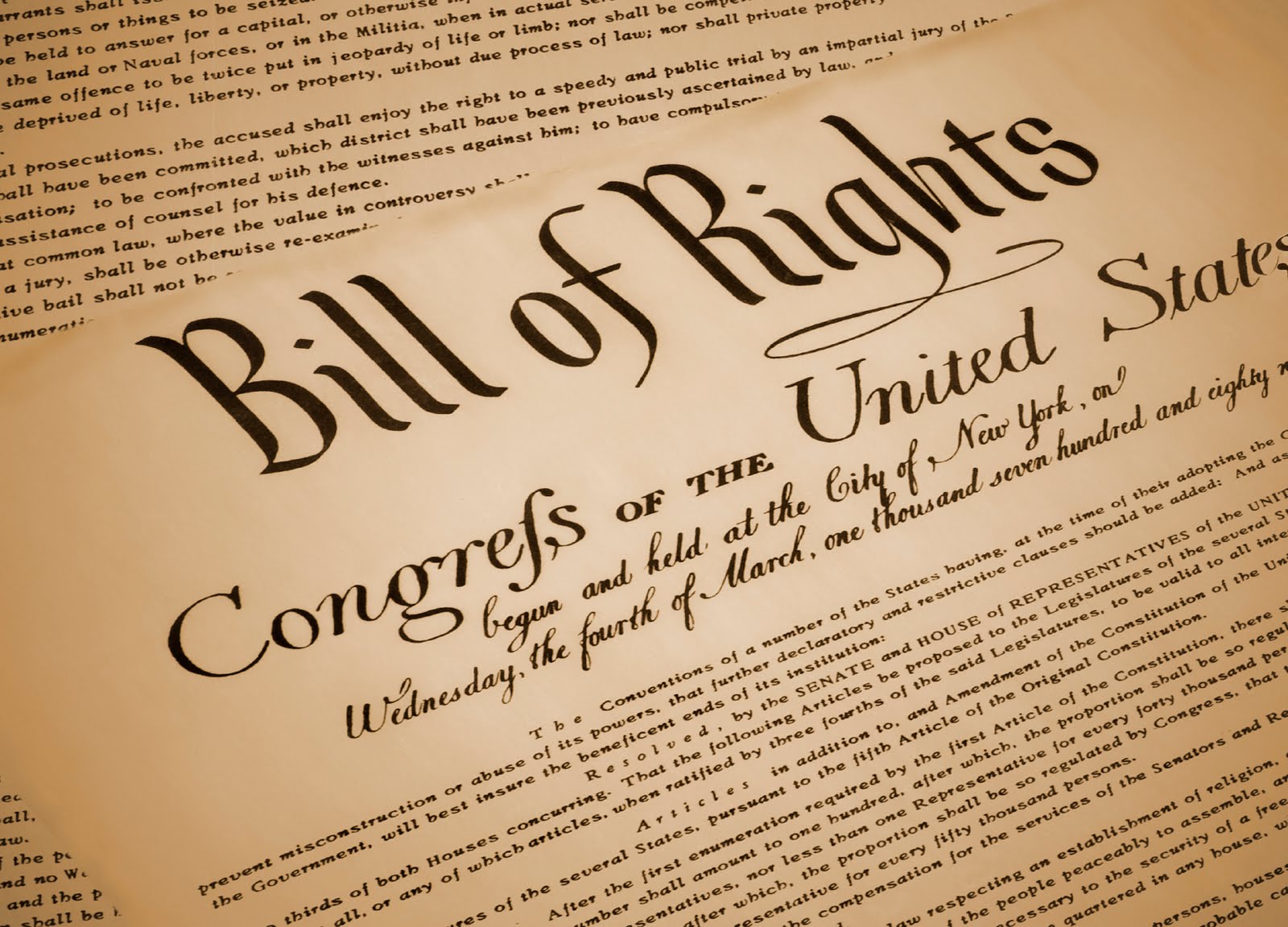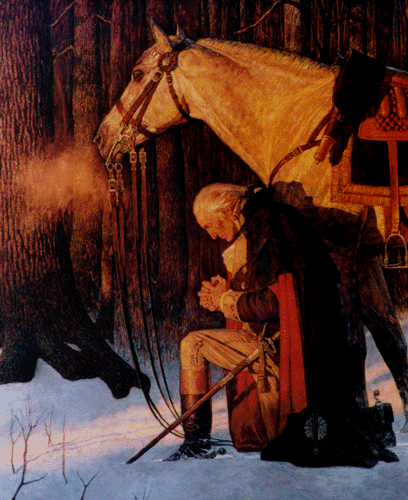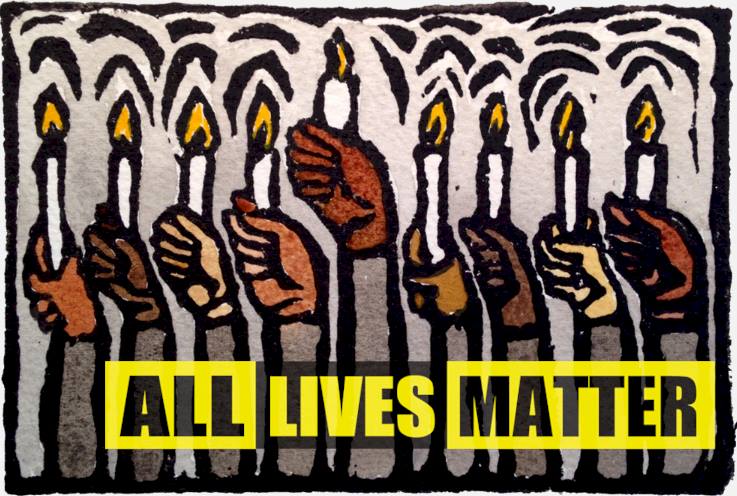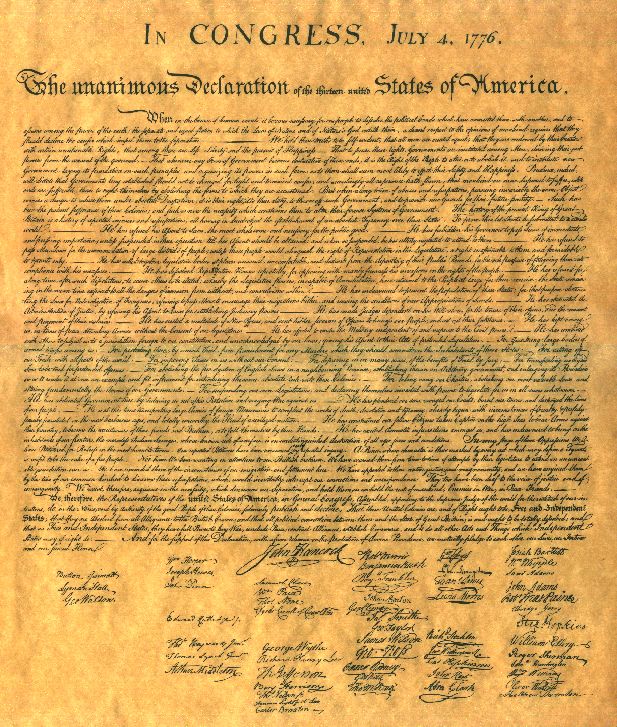Historic Documents

– Declaration of Independence (1776)
- Magna Carta – Written in England in 1215, it has withstood the test of time as a defender of justice and natural rights. The Fifth Amendment to the Constitution (“no person shall . . . be deprived of life, liberty, or property, without due process of law.”) is a direct descendant of its guarantee of justice.
- Articles of Confederation (1777) (Served as the United States’ first constitution. In force from March 1, 1781, until 1789 when present day Constitution went into effect.)
- Treaty of Paris (1783) (Ended the American Revolution and formally recognized the United States as an independent nation.)
- Federalist Papers (1787-1788) (Essays written by by James Madison, Alexander Hamilton, and John Jay to promote the ratification of the Constitution.)
- President George Washington’s First Inaugural Speech (1789)
- President George Washington’s Farewell Address (1796) (Warned American citizens to be a cohesive unit and avoid political parties. Also issued a special warning to be wary of attachments and entanglements with other nations.)
- Treaty of Ghent (1814) (End of war of 1812 between Great Britain and the United States)
- McCulloch v. Maryland (1819) (Federal power and commerce)
- Missouri Compromise (1820) (Codified slave vs non-slave states)
- Monroe Doctrine (1823) (Warned European powers not to interfere in the affairs of the Western Hemisphere.)
- Gibbons v. Ogden (1824) (The right of Congress to regulate Commerce)
- President Andrew Jackson’s Message to Congress ‘On Indian Removal’ (1830) (Begetting the Trail of Tears)
- Treaty of Guadalupe Hidalgo (1848) (Mexico cedes territory now within boundaries of United States)
- Compromise of 1850 (1850) (Addressed issues of slavery – made California a free state, but strengthened the fugitive slave act.)
- Kansas-Nebraska Act (1854) (Repealed the Missouri Compromise and started the fighting against slavery all over again.)
- Dred Scott v. Sanford (1857) (Stated slaves were not citizens and were not protected under the constitution.)
- Gettysburg Address (1863) (Lincoln’s memorable speech given at a dedication to a cemetery for Union war dead.)
- Emancipation Proclamation (1863) (Freeing the slaves)
- 13th Amendment to the U.S. Constitution: Abolition of Slavery (1865)
- 14th Amendment to the U.S. Constitution: Civil Rights (1868)
- 15th Amendment to the U.S. Constitution: Voting Rights (1870)
- Dawes Act (1887) (“An Act to Provide for the Allotment of Lands in Severalty to Indians on the Various Reservations,” known as the Dawes Act, emphasized severalty, the treatment of Native Americans as individuals rather than as members of tribes.)
- Plessy v. Ferguson (1896) (Equal but Separate)
- The Curtis Act (1898) – “An act for the protection of the people of the Indian Territory, and for other purposes”
- Joint Resolution to Provide for Annexing the Hawaiian Islands to the United States (1898)
- Theodore Roosevelt’s Corollary to the Monroe Doctrine (1905) (not only were the nations of the Western Hemisphere not open to colonization by European powers, but that the United States had the responsibility to preserve order and protect life and property in those countries.)
- 16th Amendment to the U.S. Constitution: Federal Income Tax (1913)
- 17th Amendment to the U.S. Constitution: Direct Election of U.S. Senators (1913)
- Zimmermann Telegram (1917) (Revealed plot by Germany to give US land to Mexico in exchange for war assistance. This telegram was pivitol to enflaming US anger – which resulted in the US joining the war against Germany.)
- Joint Address to Congress Leading to a Declaration of War Against Germany (1917)
- President Woodrow Wilson’s 14 Points (1918) (for world peace)
- 19th Amendment to the U.S. Constitution: Women’s Right to Vote (1920)
- Social Security Act (1935)
- President Franklin Roosevelt’s Radio Address unveiling the second half of the New Deal (1936)
- President Franklin Roosevelt’s Annual Message (Four Freedoms) to Congress (1941)
- Joint Address to Congress Leading to a Declaration of War Against Japan (1941)
- Executive Order 9066: Resulting in the Relocation of Japanese (1942)
- General Dwight D. Eisenhower’s Order of the Day (1944)
- Manhattan Project Notebook (1942) ( Recorded here is the world’s first controlled, self-sustaining nuclear chain reaction, achieved on December 2, 1942.)
- Surrender of Germany (1945)
- United Nations Charter (1945)
- Surrender of Japan (1945)
- Truman Doctrine (1947) (asked Congress for $400 million in military and economic assistance for Turkey and Greece.)
- Marshall Plan (1948) ( named for Secretary of State George Marshall, who in 1947 proposed that the United States provide economic assistance to restore the economic infrastructure of postwar Europe.)
- Press Release Announcing U.S. Recognition of Israel (1948)
- Executive Order 9981: Desegregation of the Armed Forces (1948)
- Armistice Agreement for the Restoration of the South Korean State (1953)
- Senate Resolution 301: Censure of Senator Joseph McCarthy (1954)
- Brown v. Board of Education (1954) (signaled the end of legalized racial segregation in the schools of the United States, overruling the “separate but equal” principle set forth in the 1896 Plessy v. Ferguson case.)
- Executive Order 10730: Desegregation of Central High School (1957)
- President Dwight D. Eisenhower’s Farewell Address (1961)
- President John F. Kennedy’s Inaugural Address (1961)
- Executive Order 10924: Establishment of the Peace Corps. (1961)
- Transcript of John Glenn’s Official Communication with the Command Center (1962)
- Aerial Photograph of Missiles in Cuba (1962)
- Test Ban Treaty (1963) (signed by the United States, Great Britain, and the Soviet Union: banned nuclear weapons testing in the atmosphere, in outer space, and under water.)
- Official Program for the March on Washington (1963)
- Civil Rights Act (1964) (prohibited discrimination in public places, provided for the integration of schools and other public facilities, and made employment discrimination illegal.)
- Social Security Act Amendments (1965) (established Medicare, a health insurance program for the elderly, and Medicaid, a health insurance program for the poor.)
- Voting Rights Act (1965) (outlawed voting practices adopted in many southern states after the Civil War, including literacy tests as a prerequisite to voting.)
Party Statements:
A sampling of treaties through the years…
- Treaty with the Delawares, 1778
- Treaty with the Six Nations, 1784
- Treaty with the Cherokee, 1785
- Treaty with the Cherokee, 1794
- Treaty with the Oneida, etc., 1794
- Treaty with the Mohawk, 1797
- Treaty with the Eel River, etc. 1803
- Treaty with the Ottawa, etc. 1807
- Treaty with the Osage, 1808
- Treaty with the Chippewa, etc. 1808
- Supplementary Treaty with the Miami, etc. 1809
- Treaty with the Kickapoo, 1809
- Treaty with the Yankton Sioux, 1815
- Treaty with the Chippewa, 1819
- Treaty with the Sauk and Foxes, 1832
- Treaty with the Chippewa of Mississippi and Lake Superior, 1847
- Treaty with the Pillager band of Chippewa Indians, 1847
- Treaty with the Navaho, 1849
- Treaty with the Utah, 1849
- Treaty with the Sioux—Sisseton and Wahpeton Bands, 1851
- Treaty with the Omaha, 1854
- Treaty with the Dwamish, Suquamish, etc.1855
- Treaty with the Nez Perces, 1855
- Treaty with the Yakima, 1855
- Treaty with the Winnebago, 1855
- Treaty with the Flatheads, etc. 1855. (Hellgate Treaty)
- Treaty with the Tribes of Middle Oregon, 1855
- Treaty with the Blackfeet, 1855
- Treaty with the Kiowa, Comanche, and Apache,1867
- Treaty with the Sioux – Sisseton and Wahpeton Bands,1867
- Treaty with the Ute, 1868
- Treaty with the Cherokee, 1868
- Treaty of Fort Laramie (1868) (Also known as TREATY WITH THE SIOUX—BRULÉ, OGLALA, MINICONJOU, YANKTONAI, HUNKPAPA, BLACKFEET, CUTHEAD, TWO KETTLE, SANS ARCS, AND SANTEE—AND ARAPAHO, 1868. – Setting aside the Black Hills for the Sioux Tribe, detailing how tribal members become owners of their own property, how the tribe is to handle criminal behavior, and detailing how benefits are to be distributed and for how long.)
- Treaty with the Northern Cheyenne and Northern Arapaho, 1868
- Agreement with the Sisseton and Wahpeton Bands of Sioux Indians, Appendix, 1872 (Includes Spirit Lake)
- Amended Agreement with Certain Sioux Indians, Appendix, 1873 (Includes Spirit Lake)
- Agreement with the Crows, Appendix, 1880
- Agreement with the Sioux of Various Tribes, Appendix, 1882-83
- Agreement with the Columbia and Colville, Appendix, 1883
- The Curtis Act (1898) – “An act for the protection of the people of the Indian Territory, and for other purposes” – http://definitions.uslegal.com/c/curtis-act/ – “The Curtis Act of 1898 brought in changes to the Dawes Act of 1887 that intended to bring in the concept of individual land holdings. The Curtis Act amended the allotment process in the lands of the Five Civilized Tribes of Oklahoma: the Choctaw, Chickasaw, Creek, Cherokee, and Seminole. This Act is named after Charles Curtis, [Kaw tribal member], principal author of the Act, and at that time a member of the House of Representatives… This Act provides protection to the people of Indian territory. This Act helped to weaken and dissolve Indian Territory tribal governments by abolishing tribal courts and subjecting all persons in the territory to federal law. This Act also sanctioned the establishment of public schools.” –
^(Editor note – Rep. Curtis, who went on to become our 31st Vice President, was a member of the Kaw tribe. Understanding that tribal governments are not required to run on a system of checks and balances and can infringe on the rights of individuals, he authored this act to protect the property rights of tribal members.)

